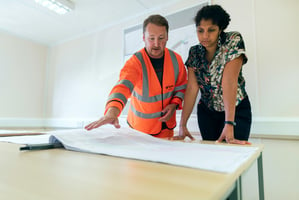Large scale infrastructure projects and developments provide enormous benefits to the communities...
The future of urban housing

Urban planning is evolving, advancing to meet the economic and social demands that the modern world faces.
People continue to be attracted to life in urban areas, meaning cities will have to grow in residential capacity in the future, while maintaining high standards of living.
With the cost of living rising, and the price of homes in London at an all-time high, developers will have to think how best to provide good quality, affordable living space to meet the need.
Here, we look at the future of modern, urban housing and some of the ways the challenges the sector faces might be tackled.
A green approach
Cities have come a long way over the years, from smog-filled landscapes with choking air to places with limits on carbon emissions and the promotion of more active travel.
The future is undeniably green, and the vital importance of this in relation to climate anxiety means city planners will need to have this front of mind when developing housing in the future.
Shared infrastructure could be a way of reusing energy produced in the city to heat homes and provide power while well-designed infrastructure could promote walking and cycling.
Energy efficiency will be a top priority in any project going forward, while public green spaces like parks and rooftop gardens should be included in any development.
However the city landscape develops, the environmental impact will have to be top of the agenda.
Maximising space
One of the big tests the housing sector will face in urban areas is how to maximise the use of space.
Over the last 25 years we have already seen the London skyline transform, with high-rise office buildings and skyscrapers consistently rising from the ground.
Building up rather than out may be one of the solutions to urban planning – using height to increase residential living space.
However, this comes with its challenges too, as London and many other cities, have strict planning laws on the height of buildings, and many see high rises as a blot on the landscape.
Affordability
Affordability of housing, particularly in London, is one of the main challenges planners face in the coming years.
Cities are attractive places to live – full of career opportunities and thriving cultural calendars – but home prices continue to rise, making it difficult for many, particularly young people, to afford to live.
Increasing the supply of housing is one way to reduce the price of rents and the purchasing of homes, so planners will need to think about how to provide accommodation at a lower price while maintaining high standards of city living.
15-minute cities
There has been much talk of 15-minute cities among planners, a concept that aims to build communities with local amenities within easy reach of residents.
The concept promotes cycling and walking as a means of getting around, with the hope of reducing traffic and pollution in busy urban areas.
However, the idea has also faced criticism, with increased costs for infrastructure and transport as well the potential for gentrification among its potential downsides.
Its benefits – thriving local communities, with clean air and less traffic congestion – are very attractive, but as a new concept for urban planning, it may take some time for this innovative idea to gain the momentum needed for full public approval.
Innovation and strong planning
Urban planners are facing huge challenges in coping with the number of people who want to move to a city, keeping accommodation affordable yet maintaining standards of living.
Innovation will be key to tackling these problems, alongside new ideas and strategies to lower living costs while promoting thriving communities and greener living spaces.
Urban Thinking provides a range of services to support developers in rising to these challenges, from project planning to environmental impact monitoring.
If you would like to know more about Urban Thinking and the project planning services we provide, see here.



